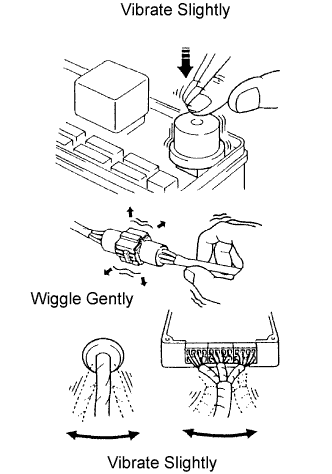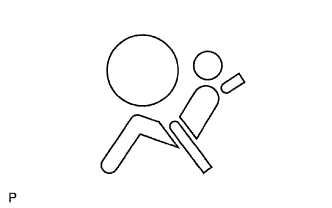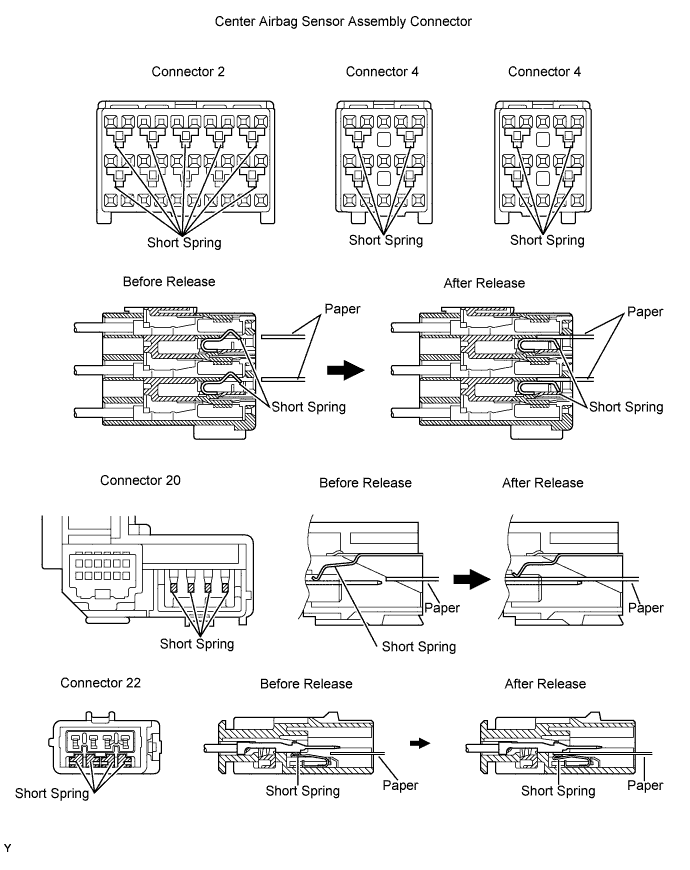Airbag System (For Sedan) -- Diagnosis System |
| CHECK DLC3 |
Check the DLC3 (YARIS_NCP93 RM000000UZ209YX.html).
| SYMPTOM SIMULATION |
- HINT:
- The most difficult case in troubleshooting is when no symptoms occur. In such cases, a thorough customer problem analysis must be carried out. Then the same or similar conditions and environment in which the problem occurred in the customer's vehicle should be simulated. No matter how experienced or skilled a technician may be, if he proceeds to troubleshoot without confirming the problem symptoms, he will likely overlook something important and make a wrong guess at some points in the repair operation.
- This leads to a standstill in troubleshooting.
Simulation method: When vibration seems to be the major cause
- HINT:
- Perform this method only during the primary check period (for approximately 6 seconds after the ignition switch is turned to the on position).
Use your finger to slightly vibrate the part of the sensor considered to be the problem cause, and check whether the malfunction recurs.
- HINT:
- Wiggling the relays too strongly may result in open relays.
Gently wiggle the connector.
Slightly shake the wire harness vertically and horizontally.
The connector joint and fulcrum of the vibration are the major areas to be checked thoroughly.
 |
| FUNCTION OF SRS WARNING LIGHT |
Primary check
Turn the ignition switch to the lock position. Wait for at least 2 seconds, then turn the ignition switch to the on position. The SRS warning light comes on for approximately 6 seconds and the SRS airbag system diagnosis (including the seat belt pretensioner) is performed.
- HINT:
- If any malfunctions are detected during the primary check, the SRS warning light remains on even after the primary check period has elapsed.
Constant check
After the primary check, the center airbag sensor assembly constantly monitors the SRS airbag system for trouble.
- HINT:
- If any malfunctions are detected during the constant check, the center airbag sensor assembly functions as follows:
- The SRS warning light comes on.
- The SRS warning light goes off, and then comes on again. This blinking pattern indicates a source voltage drop. The SRS warning light goes off 10 seconds after the source voltage returns to normal.
Review
When the airbag system is normal:
The SRS warning light comes on only during the primary check period (for approximately 6 seconds after the ignition switch is turned to the on position).When the airbag system malfunctions:
- The SRS warning light blinks after the primary check period has elapsed.
- The SRS warning light goes off after the primary check, but comes on again during the constant check.
- The SRS warning light remains off even after the ignition switch is turned from lock to on. However, if malfunctions such as an open circuit have occurred in the wire harness between the meter and ECU, the warning light comes on 10 seconds after the ignition switch is turned on.
- HINT:
- The center airbag sensor assembly keeps the SRS warning light on if any malfunctions have been detected in the airbag system.
- The SRS warning light blinks after the primary check period has elapsed.
| SRS WARNING LIGHT CHECK |
Turn the ignition switch to the on position, and check that the SRS warning light comes on for approximately 6 seconds (primary check).
Check that the SRS warning light goes off approximately 6 seconds after the ignition switch is turned to the on position (constant check).
- HINT:
- When any of the following symptoms occur, refer to the Problem Symptoms Table (YARIS_NCP93 RM000001AJL00SX.html).
- The SRS warning light comes on occasionally, after the primary check period has elapsed.
- Even when the SRS warning light comes on, no DTCs are set.
- Even when the ignition switch is turned from the lock to on position, the SRS warning light remains off.
 |
| CHECK PASSENGER AIRBAG ON/OFF INDICATOR |
Turn the ignition switch to ON.
Check that the passenger airbag ON/OFF indicator ("ON" and "OFF") comes on for approximately 4 seconds, then goes off for approximately 2 seconds.
- HINT:
- Refer to the table in the previous step regarding the passenger airbag ON/OFF indicator when the ignition switch is turned to ON and approximately 6 seconds have passed.
 |
| ACTIVATION PREVENTION MECHANISM |
FUNCTION OF ACTIVATION PREVENTION MECHANISM
An activation prevention mechanism is built into the connector (on the center airbag sensor assembly side) of the airbag system squib circuit to prevent accidental airbag activation.
This mechanism closes the circuit when the connector is disconnected by bringing the short spring into contact with the terminals and shutting off external electricity to prevent accidental airbag activation.
RELEASE METHOD OF ACTIVATION PREVENTION MECHANISM
To release the activation prevention mechanism, insert a piece of paper with the same thickness as the male terminal (approximately 0.5 mm [0.020 in.]) between the terminals and the short spring to break the connection.
Refer to the illustrations on the next 3 pages concerning connectors to utilize the activation prevention mechanism and its release method.
- CAUTION:
- Never release the activation prevention mechanism on the squib connector even when inspecting with the squib disconnected.
- NOTICE:
- Do not release the activation prevention mechanism unless specifically directed by the troubleshooting procedure.
- To prevent the terminal and the short spring from being damaged, always use a piece of paper that is the same thickness as the male terminal.


